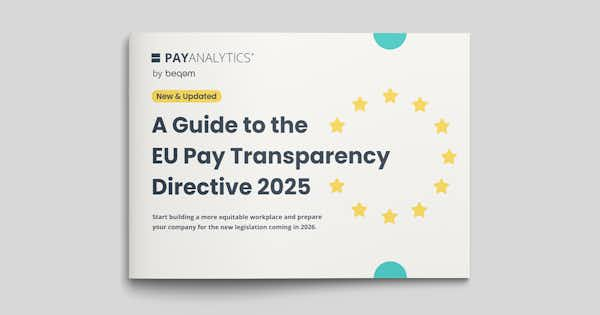A Guide to the EU Pay Transparency Directive 2025 | Download our eGuide for free
Measure

Pay Equity Analysis
Pay equity helps clarify pay structures by identifying drivers of compensation, allowing informed decisions and confident progress.
Overview of all product features
Meet your pay equity goals with the PayAnalytics software. It is designed to get you up and running with minimal setup—supported by video tutorials and digestible documentation.
Pay equity analysis
Reveal the factors influencing pay, make informed decisions.
Value-based comparison
Compare different jobs under the principle of “equal pay for work of equal value”.
Workforce analytics
Examine and enhance diversity, guide DEI efforts effectively within your organization.
Remediation Actions
Get customized recommendations to close pay gaps, tailored to your needs and budget.
Reports
Essential tools for global compliance and customizable reports for leadership.
Compensation Assistant
Help sustain a bias-free workplace by ensuring good compensation decisions.
Data Management
Refine imported data easily in PayAnalytics with corrections, edits, and additions, ensuring accuracy and visibility.
Job Evaluation
Build objective compensation structures, compare diverse roles based on organizational value.
User Access Controls
Fine-grained access controls, because users have different data access needs.

Are you ready for the EU Pay Transparency Directive? We’ve put together an eGuide to help you learn about the requirements and ensure compliance.
Resources overview
We've put together a knowledge center to help you navigate all things pay equity, DEI, and workforce analytics. This includes articles, downloadable eGuides, podcasts and more.
Guides and E-Books
Explore our how-to guides that give you practical advice on achieving workplace equity. They come in the form of long-form articles and downloadable eGuides.
Articles and blogs
Stay informed on pay equity, transparency, workplace fairness, communication strategies, and current trends.
Local requirements
Stay on top of the changing legal landscape and discover which regulations may apply to you.
The Coffee Talk Podcast
Latest pay equity news in only 8 minutes — every other Friday with Margrét & Henrike.
Customer success stories
Read about how companies have closed the pay gap with PayAnalytics.
Newsletter
Our newsletter covers topics like pay equity, compensation & benefits, DEI, legislation and software updates.

PayAnalytics acquired by beqom
PayAnalytics announced its acquisition by beqom, a leading total compensation and performance management solution provider.
About us
We believe pay is more than a number. Our software is built on over a decade of R&D by award-winning professors, pay equity experts and engineers.
Careers
Join our passionate and highly skilled team. We are pioneers in our field, aiding companies in establishing fair workplaces.
News
The latest company updates, such as events, client news, press releases and so much more.
Brand
Get an overview of our brand, awards, and history. Here you can find downloadable brand assets and photos.
Partnerships
We work with various partners to promote transparency and fairness in pay practices. Explore partnership opportunities.
Overview of all product features
Meet your pay equity goals with the PayAnalytics software. It is designed to get you up and running with minimal setup—supported by video tutorials and digestible documentation.
Pay equity analysis
Reveal the factors influencing pay, make informed decisions.
Value-based comparison
Compare different jobs under the principle of “equal pay for work of equal value”.
Workforce analytics
Examine and enhance diversity, guide DEI efforts effectively within your organization.
Remediation Actions
Get customized recommendations to close pay gaps, tailored to your needs and budget.
Reports
Essential tools for global compliance and customizable reports for leadership.
Compensation Assistant
Help sustain a bias-free workplace by ensuring good compensation decisions.
Data Management
Refine imported data easily in PayAnalytics with corrections, edits, and additions, ensuring accuracy and visibility.
Job Evaluation
Build objective compensation structures, compare diverse roles based on organizational value.
User Access Controls
Fine-grained access controls, because users have different data access needs.
Resources overview
We've put together a knowledge center to help you navigate all things pay equity, DEI, and workforce analytics. This includes articles, downloadable eGuides, podcasts and more.
Guides and E-Books
Explore our how-to guides that give you practical advice on achieving workplace equity. They come in the form of long-form articles and downloadable eGuides.
Articles and blogs
Stay informed on pay equity, transparency, workplace fairness, communication strategies, and current trends.
Local requirements
Stay on top of the changing legal landscape and discover which regulations may apply to you.
The Coffee Talk Podcast
Latest pay equity news in only 8 minutes — every other Friday with Margrét & Henrike.
Customer success stories
Read about how companies have closed the pay gap with PayAnalytics.
Newsletter
Our newsletter covers topics like pay equity, compensation & benefits, DEI, legislation and software updates.
About us
We believe pay is more than a number. Our software is built on over a decade of R&D by award-winning professors, pay equity experts and engineers.
Careers
Join our passionate and highly skilled team. We are pioneers in our field, aiding companies in establishing fair workplaces.
News
The latest company updates, such as events, client news, press releases and so much more.
Brand
Get an overview of our brand, awards, and history. Here you can find downloadable brand assets and photos.
Partnerships
We work with various partners to promote transparency and fairness in pay practices. Explore partnership opportunities.
- Home
- Newsroom
Newsroom
Discover PayAnalytics' latest news, events, and press releases. Explore our Resources Overview for comprehensive articles and in-depth material covering pay equity, DEI, and workforce analytics. Stay informed and empowered with our diverse range of content on critical topics in today's workplace landscape.
- Event
PayAnalytics will be at the WorldatWork Total Rewards conference in Cincinnati, May 20-22, 2024. Our co-founder Margrét Bjarnadóttir will be giving two talks, one on how to effectively close a pay gap and one on how to comply with the EU Pay Transparency Directive.
- Press release
PayAnalytics today announced its acquisition by beqom, a leading total compensation and performance management solution provider.
- Press release
PayAnalytics received the prestigious Icelandic Innovation Award 2023 in recognition of the global market success of our science-based easy to use pay equity software.
- Press release
Using PayAnalytics, organizations seeking EDGE Certification can now accelerate their journey toward compliance with EDGE’s high standards for diversity, equity, and inclusion.
- Event
How can your organization address pay equity issues while also coping with economic and workforce challenges? On March 14, join PayAnalytics founder Margrét Bjarnadóttir and several other pay equity solution providers for a panel discussion on this topic. This live virtual event is hosted by WorldatWork and free to attend.
- Event
PayAnalytics’ Head of Consulting, Víðir Ragnarsson, will lead a special webinar on February 16, 2023. Hosted by Willis Towers Watson (WTW) Italy, the webinar will include a presentation and software demo and will be translated live into Italian.
- Event
On December 6th 2022, PayAnalytics founder David Anderson will be giving a virtual presentation at the Algorithms, leadership, and work environment conference in Copenhagen, Denmark. The conference is arranged in collaboration between The ADD-project, the Danish union HK, the Danish union IDA – Ingeniørforeningen and the government funded data-ethical council, Dataetisk Råd.
- News
We are very excited to announce that PayAnalytics has won the Nordic Fintech Impact Award! The win was announced on September 27 during this year’s annual Nordic Fintech Week.
- News
Two of our founders, Margret Bjarnadottir and David Anderson, will speak at WorldatWork's conference this October in Austin, Texas. The Workplace Equity Forum '22 will feature speakers offering new perspectives on how to think about diversity, equity, and inclusion.
- Video
Margret spoke with Al Adamsen, the host of People Data for Good, in a recent episode about Pay Equity, Algorithms, Neutrality of Data and AI.
- News
The PayAnalytics platform is designed to support your pay equity journey every step of the way. In the last few months, we have added several new features that advance this goal.
- Video
Margrét Bjarnadóttir, Associate Professor of Management Science and Statistics and one of the founders of PayAnalytics, maps three major trends in legislation changes concerning pay equity, discussing the challenges of position and pay comparisons, implementing best practices, and increasing salary transparency. She proposes several forward-thinking options for companies, including integrating pay equity into corporate strategies to prepare for changing legislation.
Sign up for our newsletter
Our newsletter covers topics like pay equity, compensation & benefits, DEI (diversity, equity and inclusion) and legislation changes as well as news on our company and software updates.











